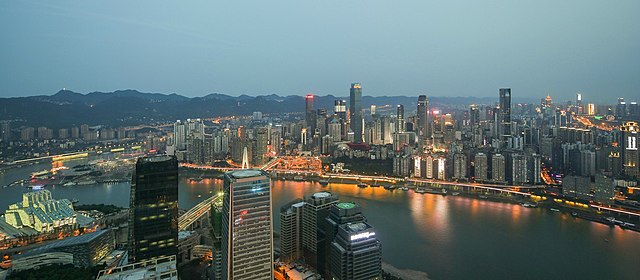by David Parmer / Tokyo
What might China be like in the next 70 years? A quick look at the PRC’s fourth Provincial Level City of Chongqing might supply a lot of the answer to that question. Located at the confluence of the mighty Yangtze and Jialing rivers in mountainous Sichuan province, Chongqing has become the economic center of western China and a key component of President Xi Jinping’s Belt and Road Initiative (BRI) for re-inventing the Silk Road.
Chongqing’s population hovers around 32 million persons with the reported addition of 1300 more people every day. Other cities struggle with the influx of migrants seeking a better life, but it appears that Chongqing has a series of coping mechanisms to deal with this influx.
One such coping mechanism is sheer size. In a country where scale is usually mind boggling, the size of Chongqing is astounding. Its estimated 82,000KM2 makes it the size of a small European country; say Belgium or Austria for example. (And yet, so much of the area where Chongqing is located is mountainous and useable land is finite and being eaten up by constant development.)
So, to a certain extent, the city can handle and utilize the migrant inflow. In addition, the city guarantees certain things to migrants including the right to employment and a pension, public housing and schools for their children. Moreover Chongqing has a modern transportation system consisting of light rail, subway and scenic monorail. This means not only affordable transportation, but also a reduction of automobiles on the road.
Chongqing’s vibrant economy, the magnet for its migrant workers, includes traditional industries like iron and steel production and manufacturing. Chongqing is also China’s largest producer of automobiles and motorcycles with several major players including Ford Motor Company having facilities there.
The city has aimed to up-market its industries to encourage more hi-tech enterprises. One step toward this was the creation of a free trade zone that saw the participation of more than 12,000 firms in fields such as AI, aerospace and medical equipment.
Chongqing features big in China’s Belt and Road Initiative (BRI). Starting in 2011, the Chongqing-Duisburg Germany rail link has seen more than 4100 trips carrying goods including personal computers to the West in a relatively-short 13-day overland trip. The city is also a party to the China-Singapore (Chongqing) Demonstration Initiative on Strategic Connectivity which met in Beijing in August 2019 to discuss cooperation in several areas including the construction of a land-sea corridor to SE Asia.
Finally, Chongqing has had, and continues to have, a robust tourist industry featuring scenic spots around the city, abundant tourist attractions, the Three Gorges Dam and its famous Sichuan cuisine including hotpot and other spicy dishes.
Chongqing could be considered the face of China future, but right now it gives a great insight into the life, struggles and triumphs of a once sleepy backwater turning itself into a truly global city of the future.
Photo: Wikipedia
 日本語
日本語 English
English 中国語
中国語